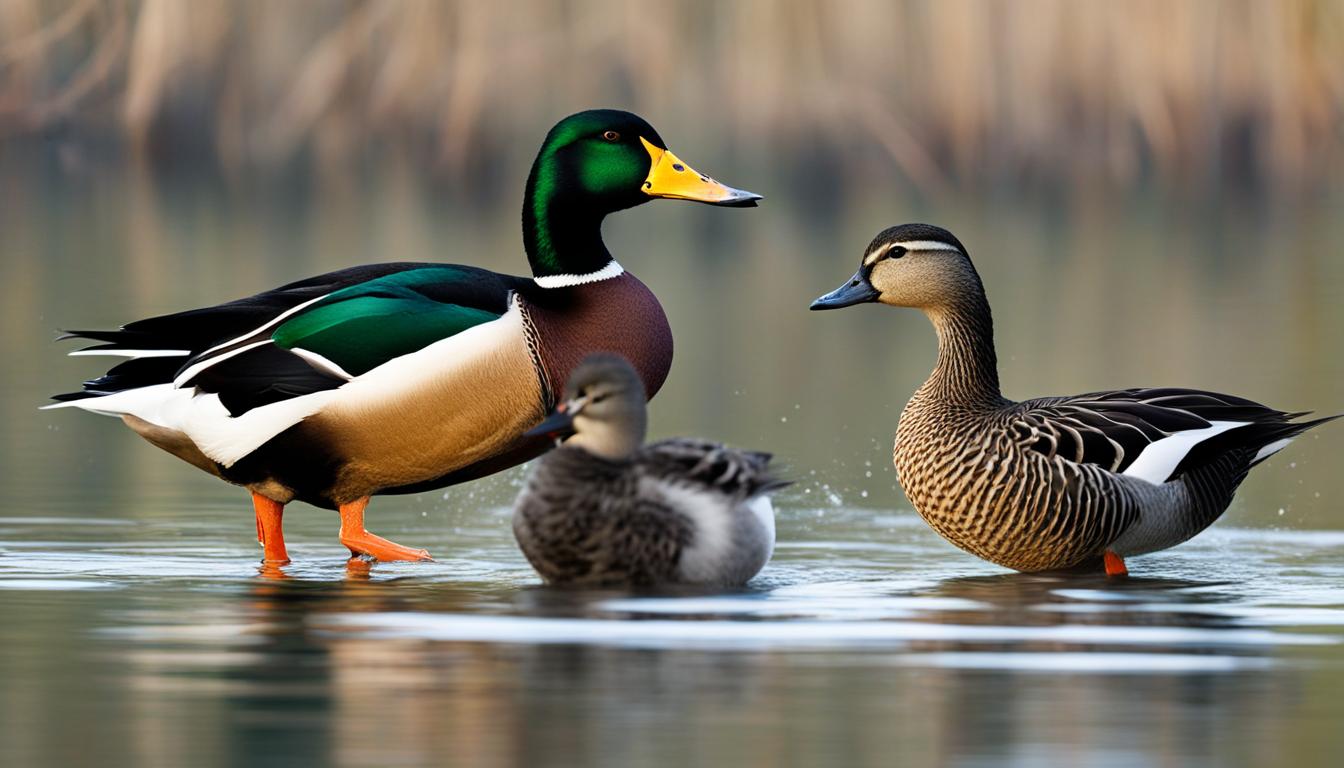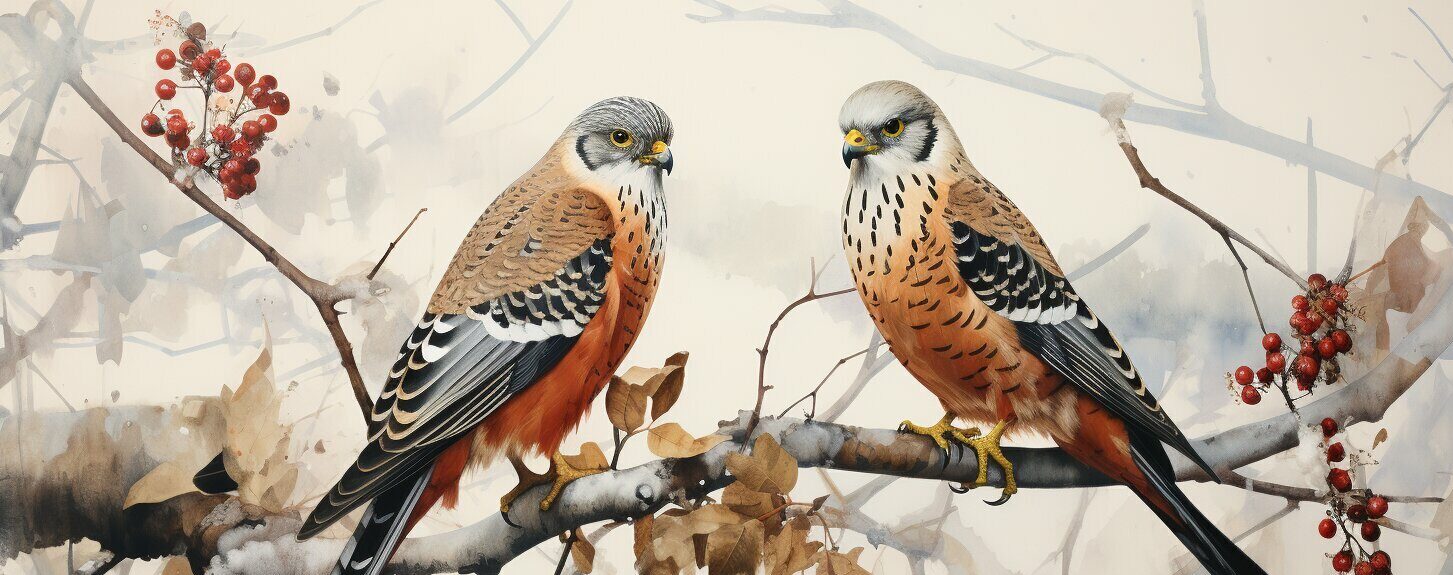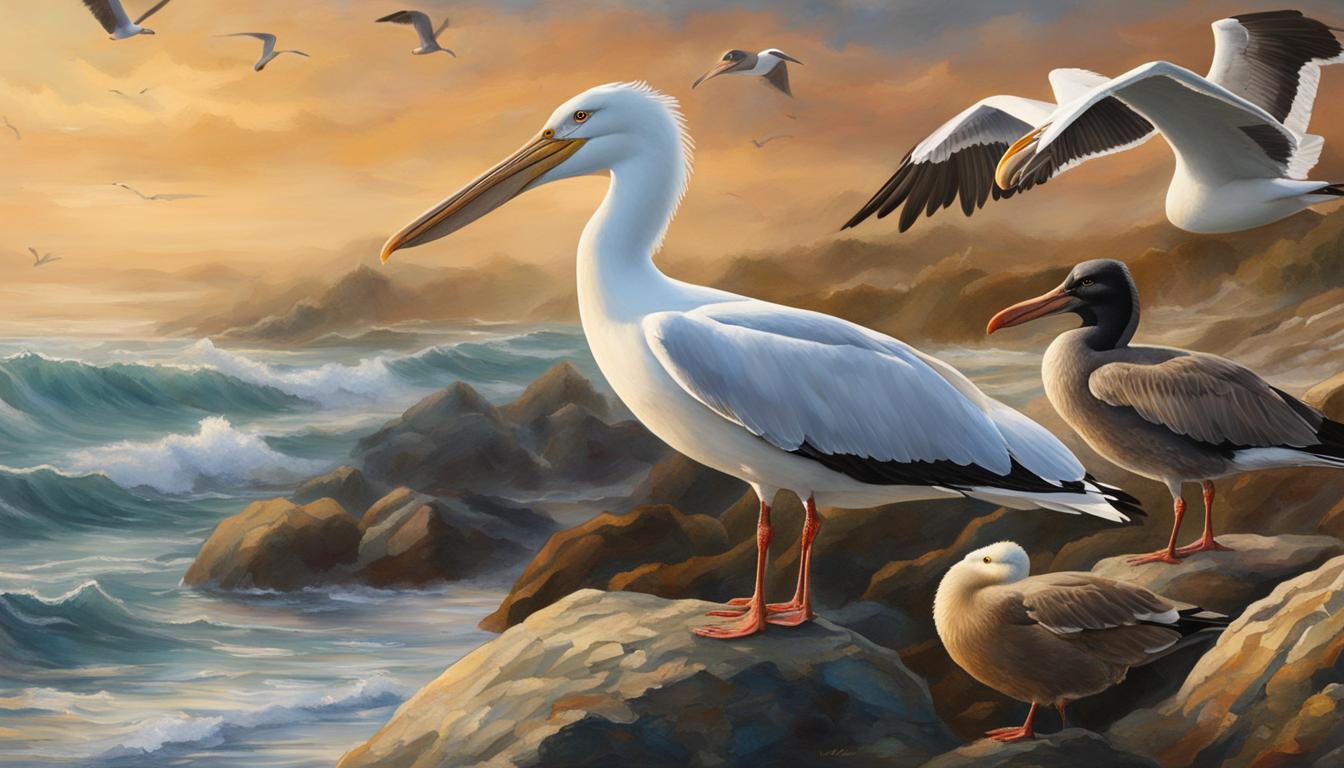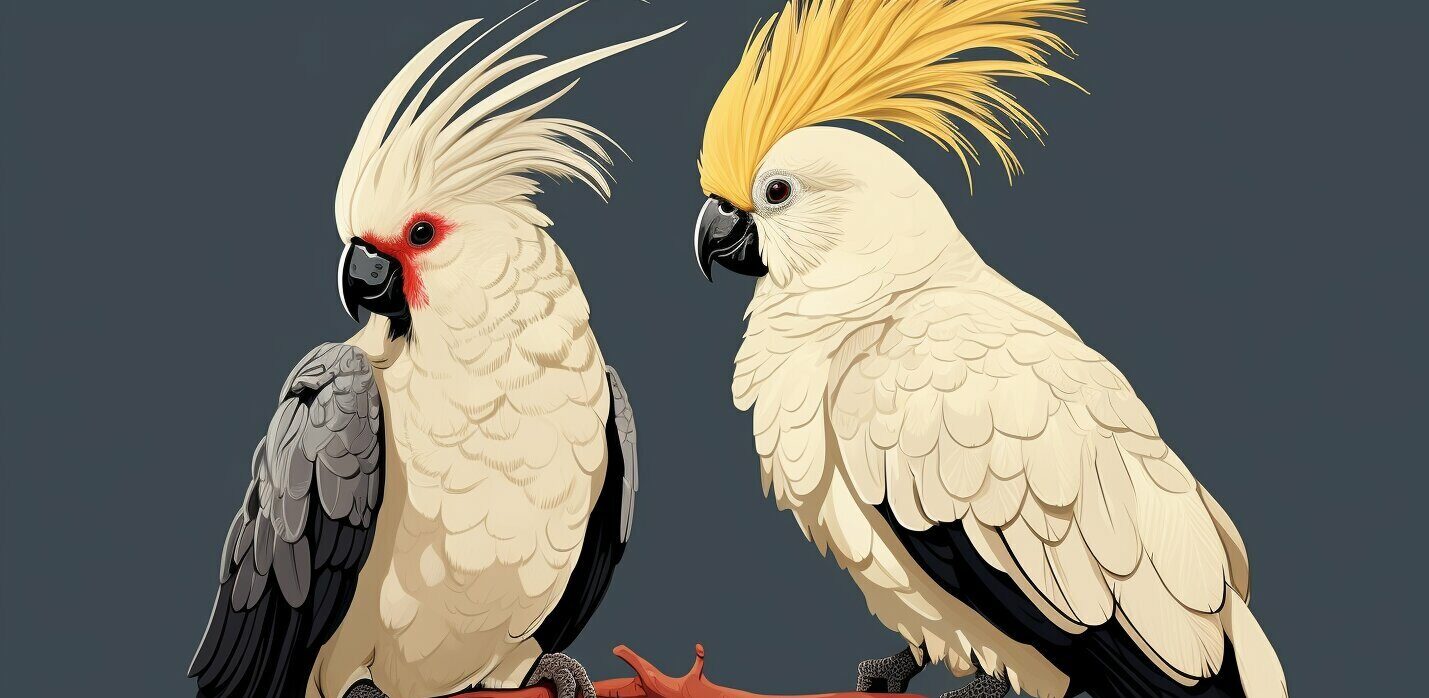As we explore the fascinating world of waterfowl, we often find ourselves wondering about the key differences between the charming ducks and the majestic geese that populate our lakes, ponds, and marshlands. This article is designed to shed light on the various aspects that set these two groups apart and to enhance our understanding of their unique behaviors, characteristics, and adaptations. In doing so, we’ll dive into the biology and life history of different duck species and goose species, ranging from their social structure and reproductive strategies to their feeding and communication habits.
Key Takeaways
- Understanding general characteristics of ducks and geese in the avian world
- Discovering their anatomical differences, from size, shape to bill configurations
- Exploring their unique behavioral traits, social structures, and reproductive habits
- Examining their habitats, migration patterns, and how they adapt to their environments
- Discussing their diets, including feeding techniques and preferred food sources
- Investigating the vocalizations and communication methods used by both groups
- Highlighting the role of ducks and geese in ecosystems and human culture
Understanding the Basics: Ducks and Geese in the Avian World
Before diving into the more nuanced differences between ducks and geese, it’s important to take a step back and familiarize ourselves with some basic similarities between ducks and geese as water birds. Belonging to the family Anatidae, both ducks and geese are considered waterfowl, with shared characteristics and behaviors that form the foundation for further comparison between these fascinating birds.
The similarities between ducks and geese extend across a range of physical traits and aspects of waterfowl behavior. For instance, both types of birds have waterproof feathers due to an oil gland located at the base of their tails, which helps them maintain buoyancy and stay dry while swimming. Additionally, both ducks and geese exhibit webbed feet, a key adaptation that enables them to paddle effortlessly through water.
When it comes to diet, both ducks and geese feed on a variety of food sources, such as aquatic plants, insects, fish, and seeds. Their appetite for such fare makes them important members of the ecosystems they inhabit, as they assist in maintaining a healthy balance.
Migratory habits are another shared characteristic of these waterfowl, with many species of ducks and geese traveling thousands of miles during seasonal migration to find suitable breeding grounds and food sources. The well-known V-shaped flying formation observed in both species allows them to conserve energy and navigate efficiently.
- Ducks – Typically smaller and more agile than geese, ducks can be found in a wide variety of habitats, such as ponds, marshes, and even suburban environments. ducks are known for their expressive vocalizations, which include the familiar quacking sound that has become synonymous with the birds.
- Geese – Generally more substantial in size than ducks, geese are often found in open landscapes, such as meadows and grasslands. Geese have a unique honking call, which can be heard during their migrations and in communication with one another.
Though similarities abound, ducks and geese show some stark differences as well. For example, geese have longer necks as compared to their smaller duck counterparts. However, beyond these easily observable distinctions, deeper insights into the unique characteristics and behaviors that differentiate ducks and geese can be uncovered.
With basic knowledge of ducks and geese in the avian world established, the following sections will dive into the more intricate distinctions between these captivating water birds, exploring the physical, behavioral, and ecological factors that set them apart.
Anatomical Differences: Size, Shape, and More
In this section, we will explore the various anatomical differences between ducks and geese, starting with their physical size and structure. This will provide a comprehensive understanding of duck characteristics and goose characteristics in terms of their bodies, beaks, and plumage.
Physical Size and Structure
Ducks and geese demonstrate significant differences in physical size and structure. Generally, geese are larger and have longer necks, while ducks have more compact bodies and shorter necks. The table below presents a comparison of average body mass, stature, and limbs proportions.
| Aspect | Duck | Goose |
|---|---|---|
| Body Mass (adult) | 0.7 – 1.6 kg | 3 – 6 kg |
| Neck Length | Short | Long |
| Leg Length | Short to medium | Medium to long |
Bill Shapes: A Tool for Survival
The duck bill shape and goose bill shape differ significantly, reflecting their distinct feeding habits and habitat adaptations. Ducks typically have flatter, broad bills, ideal for straining water and catching small aquatic invertebrates. On the other hand, geese have longer, more pointed bills which allow them to graze on grasses and other vegetation more efficiently.
These bill shape differences serve as essential tools for survival, helping ducks and geese to acquire their preferred diets and thrive in their respective habitats.
Plumage Variations
Another notable difference between ducks and geese lies in their plumage. The duck plumage is usually more colorful and patterned, especially in male ducks during the breeding season. This vibrant plumage helps to attract potential mates, as well as playing a role in camouflage and signaling during various behaviors.
In contrast, goose plumage is generally more uniform, with several species displaying few distinctive patterns or markings. Geese often exhibit a range of grays, whites, and browns, which can be helpful for camouflage in their native environments.
In conclusion, the anatomical differences between ducks and geese are not only visually apparent but have significant implications for their survival strategies, behaviors, and dietary preferences. Understanding these key differences contributes to a deeper appreciation of their unique characteristics and adaptations within the avian world.
Behavioral Traits: Social Structure and Reproduction
Both ducks and geese exhibit unique waterfowl social behavior and reproductive strategies that suit their respective environments and lifestyles. In this section, we’ll explore their social structures, mating rituals, and parenting styles, discussing similarities and contrasts between these intriguing water birds.
Social Structure Differences
Ducks typically form smaller social groups, while geese are known to establish more extensive family units. Ducks, particularly mallards, exhibit a loose social structure in which they frequently join and leave flocks at will. In contrast, geese form strong, long-lasting bonds with their families and usually stay together even after the breeding season is over.
- Duck social behavior: Small, temporary groups, often organized as pairs or during feeding and resting periods.
- Goose social behavior: Large, stable families with more extended bonds, even encompassing multiple generations at times.
Reproduction: Duck Reproduction Vs. Goose Breeding Habits
Ducks and geese differ significantly in their approaches to duck reproduction and goose breeding habits. Mating season for ducks involves courtship displays, release of hormones leading to temporary pairing, and fertilization in the water. Geese, on the other hand, establish monogamous bonds for life, with mates spending many years together and maintaining their relationships outside the breeding season.
| Mating Aspect | Ducks | Geese |
|---|---|---|
| Pairing Duration | Temporary pairs, usually last one breeding season | Long-lasting and monogamous, often last for life |
| Copulation Location | In water | On land |
| Nesting Habits | Nests near or on the ground, generally close to water | Nests on the ground, often far from water and relatively hidden |
Parenting Styles: Ducks Vs. Geese
Both ducks and geese exhibit strong parental care characteristics. However, ducks lean more towards joint parenting, with both parents protecting and caring for the chicks, in contrast to geese, who predominantly allow the mother to assume most of the parenting responsibilities.
- In many duck species, the mother lays eggs in a well-concealed nesting site, and both parents guard the nest and care for the chicks.
- Goose parents have a more defined division of roles: The female incubates the eggs while the male defends the nest, but once the goslings hatch, both parents take on parental care.
In conclusion, both ducks and geese possess fascinating waterfowl social behavior and reproductive dynamics influenced by their environmental and biological adaptations. While they share some similarities in terms of parental care, they differ significantly in their mating habits and social structures, making the study of their lifestyles an engaging and insightful journey for bird enthusiasts and researchers alike.
Habitats and Migration Patterns: Adaptations to Environment
Ducks and geese are distributed across various habitats around the world, with each species adapting to its preferred environment. In this section, we explore the duck nesting habits and goose breeding grounds, as well as the seasonal migration patterns of these waterfowl species.
Nesting Grounds and Breeding Habitats
Ducks and geese have diverse breeding and nesting habits across different species. Ducks typically nest near water sources such as ponds, marshes, and lakes. Some duck species build their nests on the ground, in tall grass or under bushes, while others, like wood ducks, nest in tree cavities or nest boxes.
Geese, on the other hand, tend to choose breeding grounds in open areas with visibility, making it easier to spot potential predators. They often build nests on elevated sites like islands, peninsulas, or hummocks in marshes. Some geese species, like the Canada goose, are known to reuse their nesting sites every year.
Seasonal Migrations: When and Where They Travel
Both ducks and geese follow seasonal migration patterns that enable them to travel long distances, from their breeding habitats to their wintering grounds. The migration patterns differ between species and are influenced by factors like food availability, breeding ground conditions, and weather patterns. The migration routes and timings of ducks and geese can be compared in the following table:
| Waterfowl | Typical Migration Routes | Migration Timing |
|---|---|---|
| Ducks | North America: Pacific, Central, and Atlantic flyways; Europe: Western and Eastern Palearctic flyways | Fall migration: August-December; Spring migration: February-May |
| Geese | North America: Pacific, Central, and Atlantic flyways; Europe: Greenland-Scotland, East Atlantic, Black Sea-Mediterranean, and East African-West Asian flyways | Fall migration: September-November; Spring migration: March-May |
Duck migration patterns and goose migration routes show that each species adjusts its migration strategy based on its specific needs and habitat preferences. Maintaining these wetland habitats and water sources is critical for ducks and geese to successfully breed and complete their seasonal migration journeys, highlighting the importance of conservation efforts.
Diet and Feeding Habits: What Do They Eat?
Both ducks and geese have various dietary preferences and feeding behaviors, largely influenced by their respective habitats and biology. In this section, we examine the different diets of ducks and geese, shedding light on their feeding habits and the factors that shape their food choices.
First, let us examine the duck diet, which usually consists of a diverse array of food sources. Depending on their species, ducks have been known to consume seeds, aquatic plants, aquatic insects, and small crustaceans like snails and shrimp. Let’s break down some key aspects of duck feeding habits:
- Dabbling ducks – These ducks, such as Mallards and Northern Pintails, generally feed by skimming the surface of the water or dabbling for food in shallow water. They typically eat a mix of aquatic plants, insects, and invertebrates.
- Diving ducks – Species like the Canvasback and the Redhead plunge into the water to forage for food, primarily targeting various aquatic plants, insects, and shellfish.
- Filter-feeding ducks – Northern Shovelers, for instance, employ a unique feeding behavior by using their spatulate bills to sift through water for tiny food particles, such as plankton and seeds.
Moving on to goose feeding habits, geese tend to consume a predominantly herbivorous diet. They graze on grass, leaves, and stems, as well as feed on aquatic plants, seeds, and grains. Unlike ducks, geese have a more restrictive diet, mainly due to their larger body size and less specialized bills. Here are some common feeding characteristics of geese:
- Geese mostly eat during daytime, with the most active feeding periods in the morning and late afternoon.
- They are more likely to be found grazing in large groups, as it allows them to watch for predators while feeding.
- Geese can consume large quantities of plant material, often stripping grassy areas bare as they graze.
To provide a clearer understanding, let us compare the dietary preferences of ducks and geese in the following table:
| Ducks | Geese |
|---|---|
| Aquatic plants, seeds, insects, and crustaceans | Grasses, leaves, stems, aquatic plants, seeds, and grains |
| Diverse feeding habits based on the species (dabbling, diving, or filter-feeding) | Grazing on land or feeding in water |
| Feed at various water depths | Feed primarily at the water’s edge or on land |
In conclusion, the duck diet is more diverse and relies on a wide range of food sources, whereas geese have a more specialized diet focused on plant material. These differences in feeding habits are influenced by their biology, habitats, and the availability of resources.
Vocalizations and Communication: Distinct Sounds of Ducks and Geese
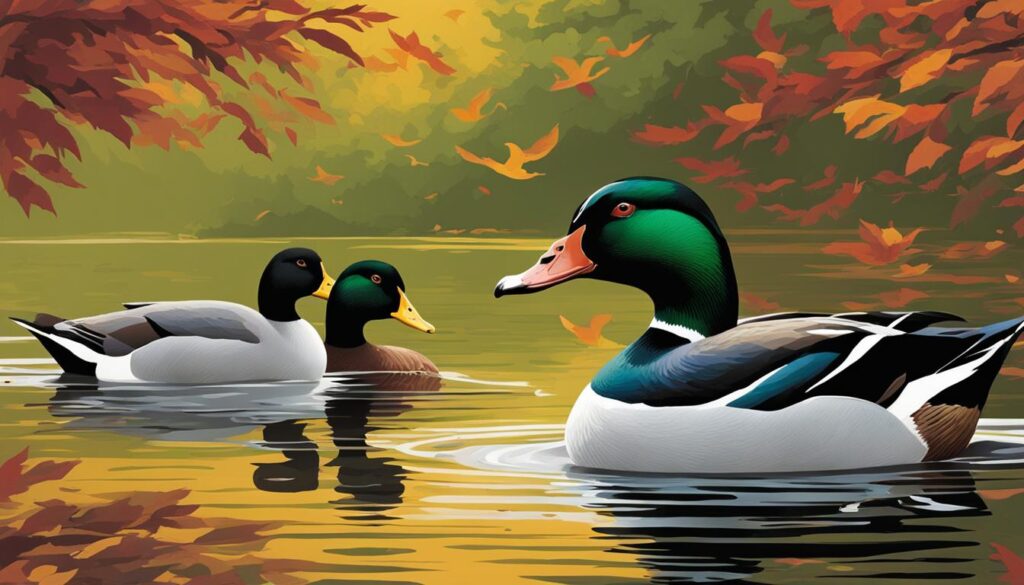
Understanding the various vocalizations of ducks and geese can provide valuable insights into their behavior, social interactions, and communication methods. This section will explore the differences between duck quacks and goose honks, as well as the role these sounds play in mating and warning calls.
Quacks vs. Honks: How They Communicate
Duck vocalizations are more commonly referred to as quacks, and they tend to be softer and more musical than goose calls. Male ducks, or drakes, produce a quiet, raspy sound, while female ducks produce the well-known, louder quack. On the other hand, goose vocalizations, or honks, are generally louder and more robust than duck calls. Geese use a variety of honks, each with a distinct meaning and purpose.
Ducks and geese communicate with their peers using these vocalizations to convey a range of messages, such as claiming territory, locating family members, and signaling distress. The following table highlights some key differences between duck quacks and goose honks.
| Duck Quacks | Goose Honks |
|---|---|
| Softer and more musical | Louder and more robust |
| Drakes produce quieter, raspy calls | Males and females have similar calls |
| Female ducks quack loudly | Honks vary in pitch and volume |
| Used for communication within species | Used for communication within and across species |
The Role of Calls in Mating and Warning
Vocalizations play a significant role in the mating rituals of ducks and geese. Male ducks use their raspy calls to attract females during the breeding season. In contrast, male geese rely on their honks alongside various displays, such as neck stretching and wing flapping, to court a mate.
Both ducks and geese use their vocalizations as warning calls to alert other members of their species to potential dangers, such as predators or environmental threats. For instance, ducks will use a series of sharp, urgent quacks, while geese will honk loudly at varying pitches and volumes depending on the situation. In both cases, these warning calls serve as essential cues for their companions to take action to protect themselves and their offspring.
In summary, the unique vocalizations of ducks and geese provide essential insights into their communication methods, social interactions, and behavior. By understanding the differences between duck quacks and goose honks, as well as the role these sounds play in mating rituals and warning calls, we can better appreciate the intricate world of these fascinating waterfowl.
Roles in Ecosystems and Human Culture: Importance and Representation
Both ducks and geese play essential roles in their respective ecosystems, with each species maintaining a delicate balance within their habitats. They are also prevalent in human culture, taking on various symbolic meanings and representing certain virtues. We will explore their waterfowl ecosystem role, as well as the significance of ducks in human culture and geese representation.
Ecological Significance: A Balancing Act
Ducks and geese are vital to their ecosystems, providing several key ecological functions. These include the following:
- Seed dispersal: Ducks and geese are known to disperse seeds from the plants they consume, promoting plant growth and aiding the propagation of various plant species.
- Prey and predator: As both prey and predators, ducks and geese maintain balance within food chains and contribute to the stability of their ecosystems.
- Nutrient cycling: Their waste products recycle nutrients, especially nitrogen and phosphorous, back into the environment, fostering plant growth and overall ecosystem productivity.
Ducks and Geese in Human Culture: Historical and Contemporary Symbolism
Throughout history, ducks and geese have been incorporated into myths, fables, and folklore, taking on symbolic meanings that continue to be represented in modern cultural contexts:
- Ducks: Ducks are often associated with creativity, agility, and resourcefulness. They are frequently used as characters in Aesop’s Fables and other traditional stories, often to teach morals and life lessons.
- Geese: Geese represent loyalty, protection, and vigilance due to their strong family bonds and ability to defend their goslings and territory. The ancient Roman author Pliny the Elder wrote of geese saving Rome from a nighttime attack, and the Greek god Zeus is often depicted in ancient art as being guarded by geese.
| Cultural Symbol | Ducks | Geese |
|---|---|---|
| Moral Stories | Aesop’s Fables | – |
| Mythology | – | Ancient Rome, Greek Mythology |
| Modern Media | Donald Duck, Daffy Duck | Mother Goose, The Ugly Duckling |
From ancient mythology to modern media, ducks and geese have been important components of human culture for centuries. By understanding their ecological roles and cultural significance, we can better appreciate the unique characteristics and contributions of these fascinating waterfowl.
Conclusion
In our exploration of waterfowl differences, we have delved into the distinct characteristics and behaviors that set ducks and geese apart. Understanding these variations helps us appreciate the complexities of the avian world and the unique roles each species plays within ecosystems. From the anatomical disparities such as bill shapes and plumage to their differing vocalizations and feeding habits, there is an intricate tapestry of evolutionary adaptations present in these fascinating creatures.
Not only have we discovered the wealth of differences between these two groups, but we have also uncovered the ways in which ducks and geese have woven themselves into human culture through symbolism and representation in various forms of media. Recognizing the importance of these waterfowl in our shared ecosystems fosters a greater appreciation for biodiversity and encourages support for conservation efforts to protect their populations.
In conclusion, understanding ducks and geese and their diverse qualities allows us to better appreciate the beauty and complexity of the natural world and inspires us to be mindful stewards of the environment that we share with these extraordinary waterfowl.
FAQ
What are the primary differences between ducks and geese?
Ducks and geese differ in several ways, including physical size and structure, bill shapes, plumage, social behavior, reproductive strategies, nesting habits, feeding preferences, vocalizations, and migration patterns.
Are ducks and geese part of the same bird family?
Yes, ducks and geese both belong to the Anatidae family within the avian world. They share certain characteristics and behaviors that define them as waterfowl, despite their differences.
How do ducks and geese compare in terms of their diet and feeding habits?
Ducks typically have a more diverse diet, consuming aquatic plants, insects, and small fish, while geese primarily graze on grass and other terrestrial plants. Their distinct bill shapes are adapted to their respective diets and habitats, helping them efficiently forage for food.
Do ducks and geese have different mating and breeding habits?
While there are some similarities between ducks and geese regarding their mating and breeding behaviors, there are also significant differences. For instance, geese often form monogamous pair bonds for life, while ducks are more likely to have multiple mates in a breeding season. Geese also tend to be more territorial and protective of their nests compared to ducks.
Do ducks and geese have different roles in their ecosystems?
Both ducks and geese play important roles in their ecosystems, such as promoting plant growth by spreading seeds and maintaining balance by consuming insects and plants. However, their individual ecosystem roles may vary depending on their specific habits, diets, and habitats.
How do the sounds made by ducks and geese differ?
Ducks are known for their “quacking” sound, which is used for communication with other ducks and can be heard over long distances. Geese, on the other hand, are recognized for their loud “honking” calls that can be used to communicate with their flock, warn of potential threats, or attract a mate.
How do ducks and geese factor into human culture and folklore?
Ducks and geese have long played a role in human culture, appearing in folklore, mythology, and art around the world. They can symbolize different themes, such as love, loyalty, determination, and even mischief. Additionally, ducks and geese both have been domesticated for thousands of years, serving as sources of food, feathers, and companionship.
 Skip to main content
Skip to main content